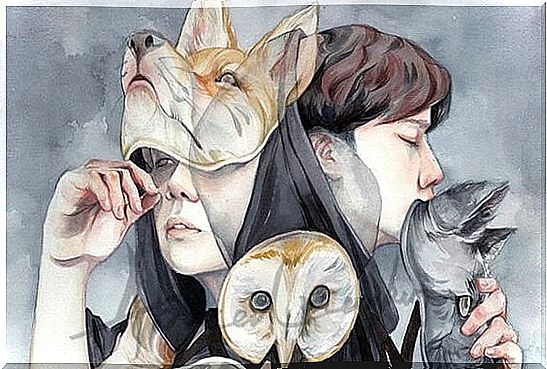7 Types Of Fake Friends We Should Recognize

Fake friends are like the dark back of the Moon. At first they dazzle us with their spells and kind attentions, but little by little we begin to sense that other side where the hollows of an interested character inhabit. That barren and desolate affectivity that almost without realizing it, saps our spirits. They are profiles that without a doubt we must know how to identify as soon as possible, especially for our emotional health.
It is often said that friendship is the best ingredient in life. So is love, there is no doubt, but what a good friend confers sometimes transcends the bonds of emotional and family relationships. Thus, this fabric built on the basis of complicity, common experiences and intense trust, is what gives us a source of eternal energy and above all, quality of life.
However, it is inevitable to find, from time to time, one of those specimens so common in our social contexts, where interest and selfishness are camouflaged under the coating of the most luminous friendship. And we fall, of course we fall. Because in our natural innocence we do not doubt for a moment that the cardinal purpose of all good friendship is to bring happiness, support and well-being.
Until it finally happens, the disappointments, the little lies, the constant contempt and the most sibylline manipulations appear. Whether we like it or not, we are facing one more of those false friends that we did not see arrive, but whom we must let go as soon as possible for health and for our own dignity …

1. Types of fake friends: the social mountaineer
One of the first false friends we usually meet early in life is the “social mountaineer.” We see them in elementary school, high school, college, and of course, in our work environments.
They are those who build ties of friendship only for one purpose: to climb positions in the social context. Thus, it is common that in their school years they seek the proximity of the most popular students or those with the best marks. Later, and in a work context, they will not hesitate to humiliate and manipulate left and right to climb positions.
2. The friend who is in good times and becomes invisible in bad times
Most of us will undoubtedly be familiar with this type of false friendship. We are talking about those people who are always around on days of calm and well-being, who sign up for any plan, any party, getaway or last minute proposal. However, when a problem or situation arises where we would most appreciate your support and interest, they disappear like the wind when closing a window …
3. The bug finder, the one who judges you
If there is something that characterizes the healthiest friendship, it is one that provides us with well-being at all times. This makes us feel good about their closeness, that we have the assurance that we will not be judged or criticized and that by spending a few hours with that person, we will leave better than we have arrived.
However, this is not the case with fake friends; with them it is common that we return home much worse than before. In fact, a typology that tends to abound is the one that has the hobby of looking for faults, drawing our attention in every mistake we make (or not) and judging us every other day as well. This type of dynamic generates considerable emotional wear.

4. The one who envies you quietly or blatantly
“It’s that you do everything well”, “those things don’t happen to you like me”, “you are always very lucky”… These and other types of phrases are the ones that those false friends often repeat to us. of their being, they envy us.
However, what is in them is low self-esteem, which leads them to this type of very unhealthy interactions for both parties.
5. The one who wants things to go well for you but not better than him
This trait of false friendship is as curious as it is common at the same time. It manifests itself in the following way: we have people who encourage us to overcome ourselves, to achieve things, however, when this happens, far from feeling happy for us, they distance themselves or show discomfort.
After such situations what there is, once again, is a marked low self-esteem. They will always feel more comfortable with us as long as we are at their height and in their same conditions. However, any hint of success or improvement puts them in evidence, plunges them into contradiction and discomfort.
6. The rival disguised as “best friend”
If you buy a mobile, do not hesitate, one of your friends will try to buy a much better one. If you join the gym, watch out, he or she will also do it to beat your marks. His goal: to be better than you in whatever you do, whatever purpose you set for yourself, or whatever achievement you achieve.
These false friends act as our nemesis, that persecuting and vengeful shadow that will try to be better than us in any area of our lives.

7. The one who manipulates you
The manipulative friend is that discreet but implacable specimen who, almost without our realizing it, anchors us with the strings of a puppet to handle us at will for a time. He will use victimhood at times, sometimes emotional blackmail and other deception and infinite Machiavellian strategies to have us in the palm of his hand and thus achieve what he wants at all times.
To conclude, as we can already intuit there are many more types of false friends: the one who criticizes, the one who betrays, the one who escapes gossip … We could describe multiple types, however, the most important of all this is that in addition to identifying them, we know how to handle them .
Sometimes, it is not necessary to resort to breaking that bond. Sometimes it is enough to make things clear, set limits and even why not, promote personal growth and self-esteem of that friend so that they are able to create healthier relationships.









